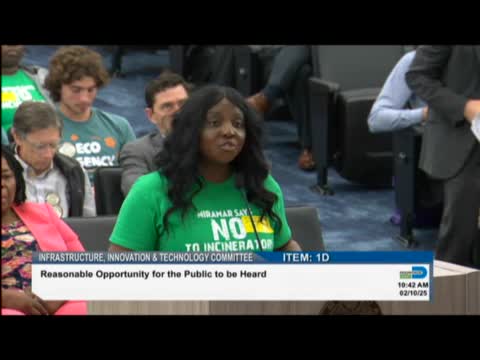Miramar residents oppose proposed incinerator citing health and environmental risks
February 10, 2025 | Miami-Dade County, Florida
This article was created by AI summarizing key points discussed. AI makes mistakes, so for full details and context, please refer to the video of the full meeting. Please report any errors so we can fix them. Report an error »

The Miami-Dade County Infrastructure, Innovation & Technology Committee meeting on February 10, 2025, focused heavily on community opposition to a proposed waste incinerator near Miramar. Residents expressed deep concerns about the potential health risks and environmental impacts associated with the incinerator, which is planned for the Airport West area.
Several speakers, including local residents and representatives from nearby cities, voiced their strong opposition. Al Salvi, a Pembroke Pines resident, highlighted the potential health risks for vulnerable populations, including the elderly and children, stating that the incinerator would exacerbate existing health issues. He urged the committee to consider the well-being of these groups when making decisions.
Fabio Naranjo, a Miramar resident, echoed these sentiments, advocating for alternative waste management solutions that prioritize recycling over incineration. He emphasized the need for collaboration between Miami-Dade and Broward County to find healthier waste disposal methods.
David Navarretti raised concerns about water quality, warning that toxic emissions from the incinerator could contaminate local water sources and harm wildlife. He pointed out the presence of protected species, such as American bald eagles, in the area.
Michael Goldstein, representing the city of Miramar, presented data indicating that the proposed incinerator would be one of the largest industrial air polluters in the county, ranking first in several harmful emissions. He urged the committee to reject the incinerator proposal entirely.
Other residents, including Judy Jower and Gabriel Martinez, emphasized the potential long-term health effects of living near an incinerator, such as respiratory disorders and cancer. They called for the committee to heed expert recommendations against the incinerator and explore more sustainable waste management options.
The meeting underscored a strong community consensus against the incinerator, with residents advocating for their health and environmental safety. The committee's next steps remain to be seen as they consider the public's concerns and the data presented.
Several speakers, including local residents and representatives from nearby cities, voiced their strong opposition. Al Salvi, a Pembroke Pines resident, highlighted the potential health risks for vulnerable populations, including the elderly and children, stating that the incinerator would exacerbate existing health issues. He urged the committee to consider the well-being of these groups when making decisions.
Fabio Naranjo, a Miramar resident, echoed these sentiments, advocating for alternative waste management solutions that prioritize recycling over incineration. He emphasized the need for collaboration between Miami-Dade and Broward County to find healthier waste disposal methods.
David Navarretti raised concerns about water quality, warning that toxic emissions from the incinerator could contaminate local water sources and harm wildlife. He pointed out the presence of protected species, such as American bald eagles, in the area.
Michael Goldstein, representing the city of Miramar, presented data indicating that the proposed incinerator would be one of the largest industrial air polluters in the county, ranking first in several harmful emissions. He urged the committee to reject the incinerator proposal entirely.
Other residents, including Judy Jower and Gabriel Martinez, emphasized the potential long-term health effects of living near an incinerator, such as respiratory disorders and cancer. They called for the committee to heed expert recommendations against the incinerator and explore more sustainable waste management options.
The meeting underscored a strong community consensus against the incinerator, with residents advocating for their health and environmental safety. The committee's next steps remain to be seen as they consider the public's concerns and the data presented.
View full meeting
This article is based on a recent meeting—watch the full video and explore the complete transcript for deeper insights into the discussion.
View full meeting